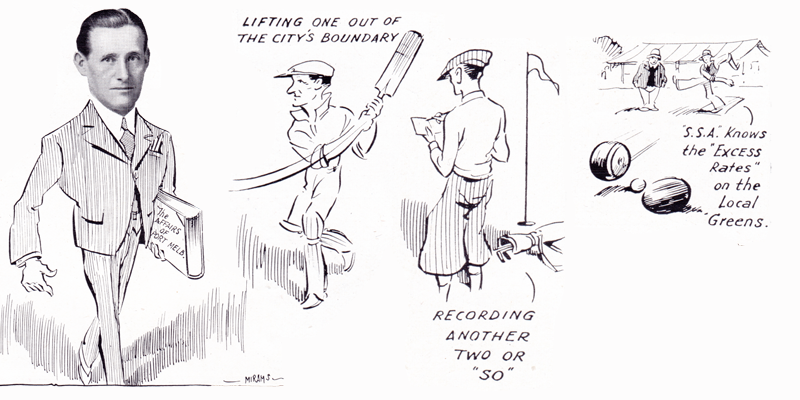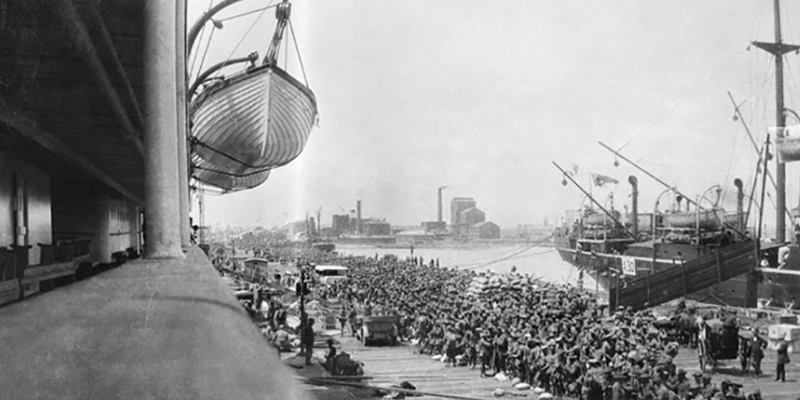Aanensen Family Portrait

Rear (L-R) Alfred Adolf (b 1890), Stanley George (b 1888), Marie Louisa (b 1893)
Middle (L-R) Albert Edward (b 1901) (being held), Bernt Andreas (b 1865) (father),
Andreas Thomas (b 1903) (being held), Edith Ann (b 1867) (mother);
Front (L-R) Aanen Harold (b 1897), Victor Bernt (b 1895),
William Ernst (b 1899).
The photo predates the birth of Berdina Grace (b 1906) and Bernt (b 1908).
This photograph represents to me the very roots of my maternal family. The close family ties as experienced by many in Port Melbourne were the foundation of my life.
My Great Grandfather Bernt Andreas Aanensen and his brother Adolph (Dolph) Mathias Aanensen supplemented their family’s Norwegian farm income by going to sea for part of the year as the farm could not support them all. This was a common practice. When their ship the “Jotun” docked in Geelong in April 1886 the brothers jumped ship and remained in Australia. Bernt was naturalised in 1897.
Bernt and Dolph married sisters Edith Ann and Grace Caroline Perrett from Geelong and both families moved to Port Melbourne. Bernt and his wife Edith purchased a house at 24 Ross Street, Port Melbourne where they raised their family of eight sons and two daughters.
Bernt and several of his sons were stevedores. All were heavily involved in the union movement. Bernt was a founding member (No. 5) of the Port Phillip Stevedores Association. After only four years of working in Australia, Bernt led the stevedores off the sailing ship ‘Loch’ as it was loading wool clipped by scabs in the Shearers Strike of 1890. Family lore indicates that Bernt rowed out in the Bay to bring renowned British Trade Unionist Tom Mann ashore in 1901 when he was denied the right to land by authorities. Bernt and his sons fought for better conditions, taking part in the waterfront strike of 1928.
Edith Ann Perrett and her younger sister Grace Caroline were born in Geelong in the late 1860s to George Walter Perrett (1821-1903) who emigrated from Wiltshire UK and his second wife Elizabeth Ann Bush (1845-1921) who came from Somerset UK.
George had previously been married for 19 years to Mary Moon (1823-1862). George along with Mary and their 8 children emigrated from England, arriving in Australia on 29 March, 1854. After the death of Mary in 1862 George married Elizabeth Bush.
Edith and Grace had 9 other siblings and eight half-siblings from their father’s first marriage. Of George’s 19 offspring, all but three survived to adulthood, 15 of them married and they produced more than 90 grandchildren. One of George’s children, William Henry Perrett, a half-brother to Edith and Grace, is described as a pioneer of the Western District and a man who was associated with the early history of Camperdown. There are numerous Perretts still living in the Geelong, Camperdown and Western Victorian region today.
Marie Louise (Lou) Aanensen, the eldest daughter of Bernt and Edith married Arthur Graham in 1916; they had two children, a daughter Edith (Edie) and a son John (Jack). Being the third eldest in a family of ten children, Lou said she had already helped to raise a large family and only wanted the two children. Arthur and Lou purchased two properties in Ross Street, Port Melbourne. Whilst Arthur was working as a stevedore, he suffered an horrendous fall down the hatch of a ship, sustaining severe injuries from which he never fully recovered. He left the wharf when the Government endorsed the wharf labour ‘pick up’ system, where men had to gather at a pick up point twice a day to see if they were selected for a day’s work. There was no guarantee of being chosen and it also became mandatory for stevedores to have licences, a practice that Arthur did not agree with.
During the depression, Arthur worked building Beach Road in Port Melbourne as part of the ‘Susso’. Arthur died at 42 as a result of the injuries sustained in the fall into the hatch, for which there was no compensation. Lou was extremely hard working and worked in many occupations, including at a ball bearing production company in Salmon Street, Port Melbourne, and during WW2, she worked at the Commonwealth Aircraft Factory at Fishermans Bend, making aeroplane wings. Lou was a talented needlewoman and knitter, making many of her own and her children’s clothes, including Jack’s first suit, cut down from an old one of Arthur’s.
Lou remained very close to her siblings, especially her younger sister Grace. They were both very active, socially and politically. They worked tirelessly for many years for the Union of Australian Women (UAW) and other groups. As members of the UAW they demonstrated for the rights of women to work for equal pay and conditions and for affordable childcare. They also fought for indigenous rights, protested against South African apartheid, and they were fervently against the Vietnam War. The UAW almost solely organised the International Women’s Day in the early years after WW2, and organised the first United Nations-sponsored international conferences for women in 1975. The UAW was an integral part of Lou and Grace’s lives.
Lou and Grace marched in the May Day parades to celebrate the introduction of the 8 hour working day. They remembered a period when there was no structured social security or health benefits and if unable to work families suffered great hardship. This caused them and many others to have a strong sense of social justice and fairness. The harshness of the times moulded a culture in Port Melbourne of caring for anyone less fortunate and even if there was little at home it was shared with others less fortunate.
My mother, Edith (Edie) Disher (nee Graham) was a product of this environment and was known for her quiet compassion and readiness to help others. Edie married Maxwell Disher shortly after the death of her father, Arthur in 1938. Edie and Max had 6 children. Although they moved around in the early years of their marriage for Max’s work they always returned to Port Melbourne. Max worked as a Transport Manager for Utah on the construction of the Eildon Weir and during WW2 helped set up the munitions factory in Adelaide after his experience at the Footscray facility prior to joining the RAAF. He served at Moratai. On his return from WW2 he worked at several occupations until finally settling at Rootes Car Manufacturers in Salmon Street, Port Melbourne. He worked there from approximately 1956 until 1967 when he died at the age 49.
Edie still had young children to raise. She had returned to work after Max’s first heart attack and continued working after his death to support her younger children. Although she had little I remember her taking in children, including a time when she had 3 teenage children whom she did not know come to stay with us while their mother was in hospital for 3 months. This was typical of my mother and the Port Melbourne of that time. This is my Port Melbourne.
Jill Dawson (nee Disher)
Jill’s entry was judged as joint People’s Choice winner in the PMHPS My Port Melbourne Photo Competition. This is an expanded version of her competition entry.


